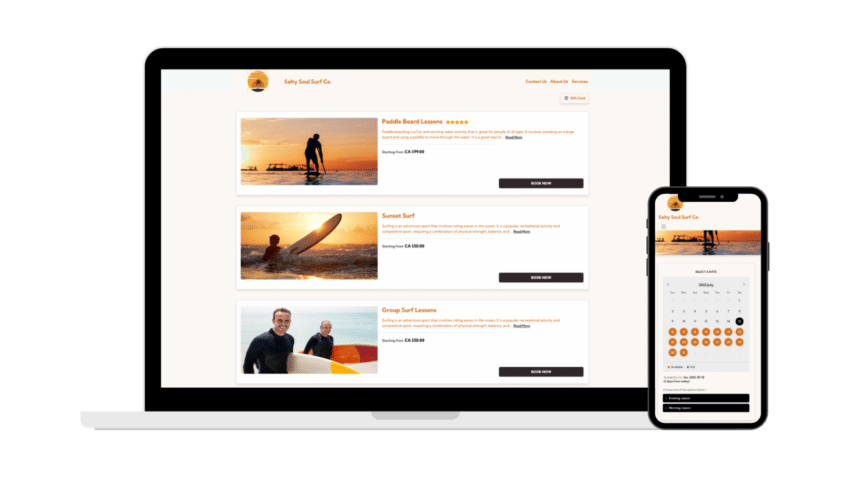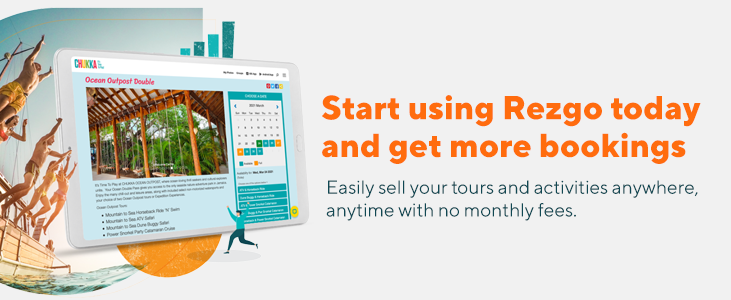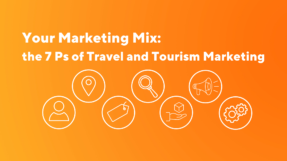Table of Contents
As a tour operator, you’re well versed in offering your guests a fantastic time while showcasing the beautiful sights and sounds of your region. So, we understand if a website that runs like clockwork might not be your top priority. The technology in our lives is expanding and advancing on what seems to be a daily basis, and not all tour owners and operators have time to keep up.
Still, giving careful thought to your tourism website essentials not only places you ahead of your competition, but also wows your guests every time they visit your website.
Why it’s important to have a great tourism website

While your physical tour offerings are one component of creating a stunning guest experience, for many of your customers, this process actually begins much sooner – on your tour booking website.
By creating and maintaining a stellar booking website for your guests, it sets you apart from your competitors and positions you as an expert in your industry. A well-rounded booking website also offers first-time visitors a seamless browsing and check-out experience.
Even if you have all of the components we’ll focus on today, a refresher is always good! Keeping up-to-date with web standards ensures your alignment with best practices for your tour booking website while impressing potential guests.
9 tourism website essentials
While there are lots of great website features available for tour operators, we’re going back to the basics with this line-up of tourism website essentials
These features alone are a great launchpoint that set you and your tour booking website up for success. Once you have these foundational features in place, you can then start to branch out and explore additional options to enhance your website.
Calls-to-Action (CTAs)

Your calls-to-action (or, CTAs for short) are what take your potential tour-goers from “just browsing” to “totally buying”. This is a crucial moment in your customer journey, as CTAs inspire potential buyers to click, connect and inevitably purchase via your website.
CTAs are often short, action-oriented and are mostly formatted as an interactive button. For your tour booking website, we suggest enabling your CTA as a “Book Now” button. When clicked, your customer is directed to your online tour booking system. In this way, a straight-forward call-to-action encourages your customer to move along in their journey with little effort.
Consider other factors such as the design, placement, size, background color and font color of your CTA button and ensure your CTA matches the action you are wanting your potential customer to take.
Content

The content on your tour booking website can be used in multiple ways to your advantage. One way is by creating clear headers and a footer that makes navigating your website a stress-free task for potential guests.
Your content can also be used to position you front and center as an expert in your industry. A blog is a prime spot for sharing relevant tips and tricks or tourism secrets with your guests and showcases your expertise as a trusted thought leader. This also has the potential to boost your SEO search engine rankings on Google, making it easier for potential customers to find you when searching for answers to their queries.
Gaining a better understanding of SEO and how it works can put you ahead of your competitors, while also creating a winning guest experience for potential customers from the moment they visit your website.
Branding

Ensure your tour booking website leaves a lasting impression on potential guests through your branding. Branding ensures your company stands out from the crowd. This is especially important if you’re listing your tours and excursions on crowded marketplaces and OTAs like Expedia or Viator.
Stellar branding can extend all the way from the name of your company, your website domain, logo and color scheme, to the way you interact and engage with your online visitors. This can include elements such as understanding your target audience, developing your brand personality and using social media to engage and interact with your customers in your brand voice. Having a consistent brand is a true tourism website essential.
Contact information
While this one might seem self-explanatory, ensuring your contact information is easy to find and up-to-date earns you brownie points with potential tour-goers visiting your website.
It’s likely your customers are going to have questions when they’re booking online with you.
Components like your company email, phone number and social media profiles can be comfortably fitted as part of their own dedicated ‘Contact Us’ page. You might also choose to nest them in your footer located at the bottom of your website. If you really want to get fancy, you could also add in live chat for potential clients to quickly flick you messages, allowing them to chat in real-time with you or your staff.
Refund or cancellation policy
In the event your guests need to reschedule their tour, or worse, cancel altogether, highlighting your refund and cancellation policy as part of your tour booking website helps potential customers know what to expect.
Placing this vital information somewhere easy to find reduces the stress and potential irritation of guests already in a disappointed headspace in having to cancel with you. Clearly outline how flexible or strict your refund policy is, how many days in the lead-up to the tour guests have to cancel and any circumstances where a refund may not be offered.
Photos

A picture’s worth a thousand words – so let the photos on your tour booking website do the talking! Visually stunning images strategically placed throughout your webpages will wow potential customers to your website. Photos showcasing the best of your tour offerings, onsite locations and guests engaging with your guides can convey to potential guests a sense of their time with you on your tour.
Photos not only help to convey your brand and who you are as a company and tour operator but also your story. Filling in the gap of the ‘why’ behind the photos and reminding guests why they should book with you, can really make a difference with your booking website.
Once you have your website’s photography down pat, giving videos a go might also be worth trialing. Dabbling in video marketing for your tour booking website can showcase the features of your tours, highlight customer testimonials and provide an inside glimpse into your company, your values and your mission.
Mobile-friendly design

Once you’ve got the desktop-version of your website down pat, it’s time to turn your attention to what your website looks like on your smartphone. One recent study noted that 48% of experience bookings take place once travelers arrive at their destination, with a majority of those searches taking place on a mobile device.
Stats like these stress the importance of getting it right using a mobile-friendly design for your website. Elements like mobile navigation and usability that meets the needs of a variety of users and customers, is part of best user experience (or, UX, for short) practices.
Having one seamless website that looks and interacts the same on both mobile and desktop, is part of providing an excellent user experience and can also help you to boost your mobile SEO rankings.
Online booking system

This one might seem like a no-brainer, but an online booking system that is easy to navigate and find (thanks to those clearly detailed CTA buttons we touched on earlier) can help potential customers facilitate their tour bookings with you.
An online system should have booking software features like live availability, details about your tours or activities, and a secure payment gateway. This can build trust and engagement with visitors to your website.
Online bookings will also make your business much easier to manage, so it’s win-win for customers and tour operators alike.
Content Management System (CMS)

This last component is more optional but can make a world of difference in being able to easily update your website’s content – a reliable content management system (or CMS for short).
A CMS can make updating, adding to and maintaining your web pages a breeze. In many cases, using a CMS like WordPress is as simple as typing in the content you want on your website, as you would a Microsoft Word doc, and hitting the publish button!
CMS-type platforms make it easy to customize your tour booking website as needed, while ensuring reliable web hosting. Better yet, a WordPress booking plugin that seamlessly integrates with your existing online booking system means less troubleshooting for you and more tour bookings for your customers.
With these 9 tourism website essentials, you’ll be ready to start taking bookings and wowing your online customers. Rezgo’s tour booking software is the perfect pairing alongside your new and improved tour booking website. Build trust with your tour guests thanks to Rezgo’s secure payment gateways and maintain clear and concise messaging using our WordPress plugin.





